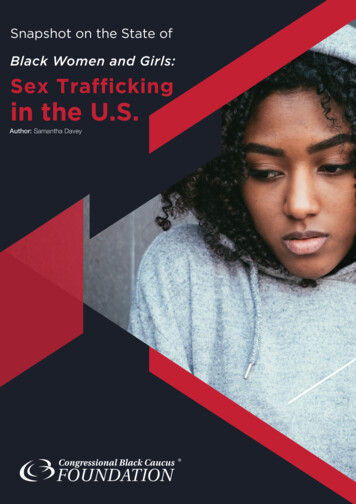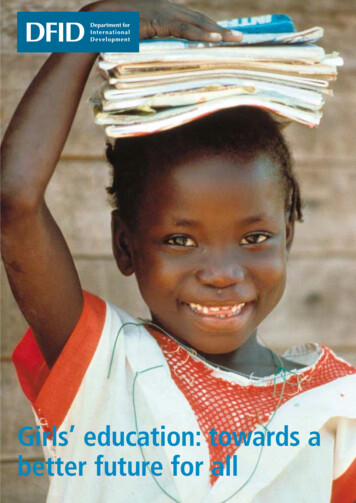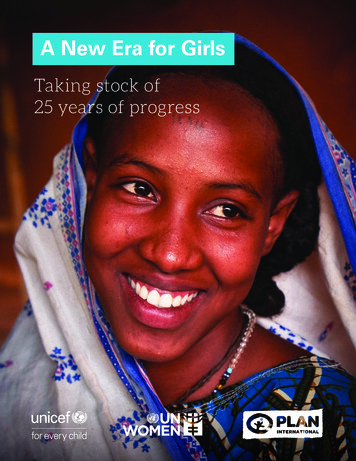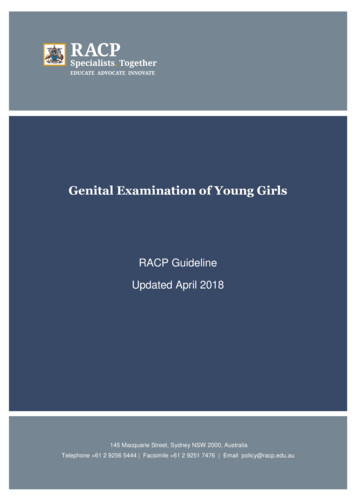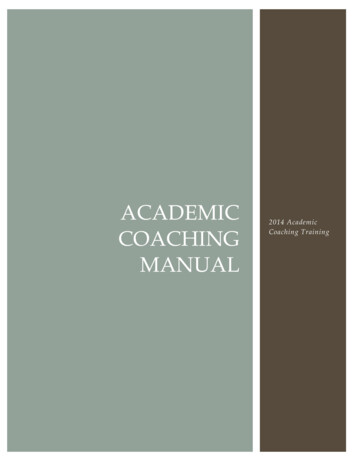
Transcription
GIRLS’ PARTICIPATION IN PHYSICAL ACTIVITIES AND SPORTS: BENEFITS, PATTERNS, INFLUENCES AND WAYS FORWARDR. Bailey, I. Wellard and H. DismoreCentre for Physical Education and Sport ResearchCanterbury Christ Church University College, UK[CONTACT: Prof Dr Richard Bailey: 44 1227 767700; rpb1@canterbury.ac.uk]IntroductionThere is an international consensus that participation in physical activities can offer a great deal to individuals,communities and nations. Evidence suggests that from an early age, differences in gender-based attitudes towardsand opportunities for sports and physical activities can have a significant influence on children’s participation. Thismay, in turn, affect later involvement in physically active lifestyles, and the social and health benefits that may resultfor them.This report offers a summary of research into girls’ participation in sports and physical activities. It focuses upon thefollowing themes: Benefits of Sports and Physical Activities; Patterns of Girls’ Participation in Sports and Physical Activities; Influences on Girls’ Participation; Examples of Innovative Practices; Recommendations.To make the paper as useful as possible for readers from different backgrounds, and to keep the main paper of amanageable size, we have appended some additional information, including some suggestions for future research inthe area of gender and physical activity, further reading, and details of relevant organisations.Benefits of Sports and Physical ActivitiesPhysical HealthThe physical health benefits of regular physical activity are well-establishedi. Regular participation in such activities isassociated with a longer and better quality of life, reduced risks of a variety of diseases and many psychological andemotional benefitsii. There is also a large body of literature showing that inactivity is one of the most significantcauses of death, disability and reduced quality of life in the developed worldiii.Physical activity may influence the physical health of girls in two ways. First, it can affect the causes of diseaseduring childhood and youth. Evidence suggests a positive relationship between physical activity and a host of factorsaffecting girls’ physical health, including diabetes, blood pressure and the ability to use fat for energyiv. Second,physical activity could reduce the risk of chronic diseases in later lifev. A number of ‘adult’ conditions, such as cancer,diabetes and coronary heart disease, have their origins in childhood, and can be aided, in part, by regular physicalactivity in the early yearsvi. Also, regular activity beginning in childhood helps to improve bone health, thus preventingosteoporosis, which predominantly affects femalesvii.Obesity deserves special mention. There seems to be a general trend towards increased childhood obesity in a largenumber of countriesviii, and this increase seems to be particularly prevalent in girls from highly urbanised areas, someethnic minorities and the disabledix. Obesity in childhood is known to have significant impact on both physical andmental health, including hyperlipidemia, hypertension and abnormal glucose tolerancex. Physical activity can be animportant feature of a weight control programme for girlsxi, increasing calorific expenditure and promoting fatreduction. Indeed, recent systematic reviews on both the prevention and treatment of childhood obesity recommendstrategies for increasing physical activityxii.Mental HealthIn recent years, there has been evidence of disturbingly high rates of mental ill-health among adolescents and evenyounger children, ranging from low-self-esteem, anxiety and depression to eating disorders, substance abuse andsuicidexiii. Adolescent girls are particularly vulnerable to anxiety and depressive disorders: by 15 years, girls are twiceas likely as boys to have experienced a major depressive episodexiv; girls are also significantly more likely than boys tohave seriously considered suicidexv.Research suggests two ways in which physical activities can contribute to mental health in girls. Firstly, there is fairlyconsistent evidence that regular activity can have a positive effect upon girls’ psychological well-being; indeed, somestudies indicate that girls may respond more strongly than boys in terms of short-term benefitsxvi. Secondly, research1
has indicated that physical activity can contribute to the reduction of problematic levels of anxiety and depression.Evidence is beginning to be gathered for exercise as a treatment for clinical depression, with studies finding thatphysical activity is as effective a treatment as anti-depressantsxvii, and psychotherapyxviii. Similarly, a variety of nonclinical studies have found that higher levels of activity were related to lower rates of depressionxix. A positionstatement of the International Society of Sport Psychologyxx drew out numerous mental health benefits of physicalactivity from the research literature, including reduced state anxiety, neuroticism and anxiety, mild to moderatedepression, and various kinds of stress.Educational and Intellectual DevelopmentA range of evidence suggests that for many girls, sports and physical activities are positive features of their academicaspirations and achievement. The classic study of the relationship between physical activity and school performancewas carried out in France in the early 1950s, in Vanvesxxi. Researchers reduced ‘academic’ curriculum time by 26%,replacing it with physical activities, yet academic results did not worsen, there were fewer discipline problems, greaterattentiveness and less absenteeism. More recent studies have found improvements for many children in academicperformance when time for physical activity is increased in their school dayxxii. A report of three longitudinal studiesemphasises that ‘academic performance is maintained or even enhanced by an increase in a student’s level of habitualphysical activity, despite a reduction in curriculum or free time for the study of academic material’xxiii.There is considerable evidence of a positive relationship between girls’ participation in sports and pro-educationalvalues, although, at present, it is difficult to distinguish between correlation and causation. Studies from the UnitedStatesxxiv report a host of encouraging findings including: girls who participate in sports are more likely to achieveacademic success than those who do not play sports; female high school athletes expressed a greater interest ingraduating from both high school and college; female athletes from ethnic minority groups reported better schoolgrades and greater involvement in extra-curricular activities than non-athletes, and in some cases are considerably lesslikely to drop-out from school. Other studies have suggested that sports participation can help undermine traditionalgender stereotyping in terms of academic aptitude, by demonstrating an association between girls’ engagement insports and improved performance in science and mathematicsxxv.Reproductive HealthAdolescent pregnancy and sexual ill-health are major social problems across the globexxvi.Although there is a shortage of research in this area, early studies conducted in the US have found that adolescentgirls who participate in sports tend to become sexually active later in life, have fewer partners, and, when sexuallyactive, make greater use of contraception than non-sporting girlsxxvii. Projects are currently underway in the developingworld that use sports participation as a strategy for empowering girls to avoid high risk sexual behaviourxxviii.Social InclusionCombating social exclusion, or ‘the multiple and changing factors resulting in people being excluded from the normalexchanges, practices and rights of modern society’xxix, has become a focus of attention for governments and nongovernment organisations in recent yearsxxx. Some writers have argued that sports not only reflect but can alsocontribute to girls’ social exclusion in sports and wider societyxxxi. Certainly, the dominance of sports as culturallyvalued physical activities, and the close identification of sports with masculinity, means that other, non-masculinegroups can become pushed to the margins. However, positive sports experiences do seem to have the potential to, atleast, contribute to the process of inclusion by: bringing individuals from a variety of social and economic backgroundtogether in a shared interest in activities that are inherently valuable; offering a sense of belonging, to a team, a clubor a programme; providing opportunities for the development of valued capabilities and competencies; and increasing‘community capital’, by developing social networks, community cohesion and civic pridexxxii.Studies of women’s experiences of sports participation have suggested that they can contribute to a more generalisedfeeling of empowermentxxxiii. In many settings, adolescents may be encouraged to view their bodies as sexual andreproductive resources for men, rather than sources of strength for themselvesxxxiv. Physical activities may help themdevelop a sense of ownership of their bodies and access the types of activity experiences traditionally enjoyed byboysxxxv. This may be because participation augments girls’ self-esteemxxxvi, or because being an athlete carries with ita strong public identityxxxvii. Some female athletes report having a stronger sense of identity and self-direction – whatTalbot calls ‘being herself through sport’xxxviii. Whatever the reasons, increasing the numbers of girls’ participating insports and physical activities does seem to open up routes through which they can acquire new community affiliationsand begin to operate more openly and equally in community life. In doing so, girls’ participation can challenge andchange social norms about their roles and capabilitiesxxxix.Patterns of Girls’ Participation in Sports and Physical ActivitiesInternational guidelines on physical activity in childhood and youth suggest that all young people should take part insports or other physical activities, be physically active on all or most days, and engage in activity that is of at least2
moderate intensity, and lasting about an hourxl. Whilst girls in many contexts do achieve these targetsxli, there isconsiderable evidence from around the world suggesting that most do notxlii.Tables 1 and 2 (below) summarise a range of empirical research into girls’ participation in sports and physicalactivities. These and other studies report a clear trend of decreasing levels of activity as girls get older, and a wideningdisparity between girls’ and boys’ physical activity behavioursxliii. For example, one US study estimated that thedecline in physical activity during secondary schooling is 7.4% for girls, compared with 2.7% for boysxliv. Anotherreport suggested that Australian female adolescents were approximately 20% less active than their male peersxlv.Since sedentary lifestyles are associated with increased risk of ill-health, both during childhood and in later life, thesefigures are cause for concern.Country1SenegalSample40(13 0.5)SourceAaron, et al (1993)CountryUSSample604 girls &641 boys (1216 years)MethodQuestionnaireAustralian BureauofStatistics(2002)xlixBaranowski, et al(1993)lAustralia22,32565 )InterviewUSObservationC.Fitness&Lifestyle ResearchInstitute (2004)Guerra,etal(2001)liCanada101 girls / 90boys(3-4years)5,303adults(15 years )InterviewLasheras, et al(2001)Raudsepp & Päll(1999)Spain232 girls & 22boys(8-13years)1,358 children(6-15 years)91 girls / 83boys(7-9years)SourceBenefice,(2001)Key FindingsEstimated levels of activity high, but cleardecline during three years of study. Girlsattending school less active than nonattenders.Bungum & Vincent US852 girls (14-18 7-dayrecall Ethnic group (white girls more active) and(1997)xlviyears)and surveyage (younger more active) significantinfluences on physical activity.Parental(especially father) support and participationin organised sports associated with activity.Cale (1996)xlviiUK103 girls (11-14 InterviewPhysical activity levels reported generallyyears)Questionnairelow: 45% of sample engaged in no vigorousactivity over 4 days; 30% did less than 20minutes activity a day.Saxena,etal US305 girls (12-21 SurveyLow levels of activity in majority of girls.(2002)xlviiiyears)Factors associated with regular vigorousactivity: friends exercising, involvement insports team, trying to lose weight, believingin importance of exercise, and being under17 years of age. Time constraints andlaziness most common reasons given forinactivity.Table 1: Selection of studies examining girls’ participation in sports and physical rometryTelephoneinterviewsReanalysisofsurvey dataParental 7-dayrecall&accelerometryFindingsBoys considerably more active than girls onall measures, and boys spent more timevigorously exercising and competing incompetitive sports than girls.Males had higher participation in every agegroup, with the difference most evident inthe 12-14 &15-19 age groups.Boys generally, but not always, more activethan girls.Teenage boys twice as likely as teenage girlsto meet international guidance on physicalactivity.Physical activity decreased significantly forall groups. Boys reported significantly moreactivities, except in 8-9 age group.Percentage of active boys higher than that ofgirls in all age categories.Significant decrease of activity with age inboth sexes. Total physical weekly activitysignificantly higher in boys than girls in 7and 8-year groups, but not at 9-years. Boys’mean daily levels of moderate-to-vigorousactivity significantly higher than girls in agegroups.‘Country’ refers to the setting of the research, rather than that of the author’s home institution.3
SingaporeSportsCouncil 270 girls /3209boys(12-15 years)Questionnaire1619 girls1651 l&(15-19InterviewRate of sports participation higher amongmales than females.With exception ofwalking, participation rates for girls lower inall most popular activities.Boys more active than girls in all .Gender difference greatest inorganised sports, although participation ofgirls has increased.&/Girls’ lower enrolment in organised sportsfully accounts for gender differences inoverall physical activity, and largely accountsfor differences in frequency of strenuousactivity.Table 2: Selection of studies comparing girls’ and boys’ participation in sports and physical activitiesInfluences on Girls’ ParticipationIt has been suggested that there is a genetic predisposition towards being more or less physically activeliv. However,any such predisposition is mediated by a host of factors, some of which are outlined in Table 3 (the discussion thatfollows will, necessarily, be selective, but further detail is available in the indicated references).Personal FactorsEnvironmental vationPeer groupAgePerceived barriersFamilyObesityPerceived competenceCultureFitness levelAttitudesRole modelsTable 3: Factors influencing girls’ participation (adapted from Sallislv)EnvironmentalAccessType of activitySchoolIndependent mobilityAgeAge is the dominant biological determinant of physical activity in girlslvi. Overall, levels of activity steadily decline fromabout 6 years of age until adolescence, when activity levels drop more steeplylvii. Whether this decline ought to beunderstood solely in terms of biological influences is dubious, and it is, perhaps, noteworthy that the decline insporting or physical activities among girls around 11 or 12 years occurs almost simultaneously with the period whengender ideology sharply interacts with socialisation influences.Perceived barriersA recent review of 108 published studies addressing correlates of physical activity identified perceived barriers as themost consistent negative psychological correlate of physical activitylviii. Studies specifically focused upon girls’perceived barriers to physical activity are still relatively rarelix, and predominantly come from the US, but themes arebeginning to emerge. Both qualitative and quantitative studies have identified girls’ wish to do other things with theirtime as a frequent explanation for non-participationlx. Other explanations for inactivity include unsuitable weather,school pressures, dissatisfaction with school physical education classes, reluctance to get sweaty or dishevelled, andinaccessibility or inconvenience of sporting provisionlxi. Summarising this data, Sallis and Owen state that, ‘It appearsthat adolescents are not just acquiring adult patterns of sedentary habits, they are also acquiring adult ways ofthinking about exercise, including reasons (or excuses) for not being active’lxii.PeersSports and physical activities are usually social events for childrenlxiii. Similarly, physically active adolescents tend tosocialise with friends who are also activelxiv. Whilst a peer group can act as powerful enforcer of norms andbehaviours for both boys and girls, there is evidence that they use and view friendships in different ways. Studiessuggest that a key factor in whether girls engage in and sustain physical activities was whether they had a same-sexfriend with whom to participatelxv. This may, in part, be due to the support structure such shared experiences canoffer, especially during adolescence, when many girls consider reducing their commitment to physical activities thatthey are most anxious about being rejected or excluded from same-sex friendshipslxvi. For girls, physical activities oftenbecome less important in their lives as they, encouraged by pressure from their peer group to seek other activitiesassociated with their preferred perceptions of femininitylxvii.4
FamilyNumerous studies have emphasised the influence of the family on childhood physical activity levelslxviii. Active parentshave been shown to have more active pre-school children, older children and adolescentslxix; activity levels are furthersupported with an active siblinglxx. Studies generally identify fathers as playing the primary role in influencingchildren’s participation in sports and physical activitieslxxi. It is noteworthy, then, that fathers have also often beenreported to be the primary socialisation agent for gender role developmentlxxii. The nature and extent of physical playopportunities depend greatly on the set of beliefs and expectations held by the parents, and these beliefs areparticularly significant in relation to genderlxxiii. Some writers have argued that involvement in physical activities is aproduct of a cultural belief system that values certain activities and skills for one sex and not for the otherlxxiv. From anearly age, many parents, in a range of cultures, treat boys and girls differently and encourage different styles of play inphysical activity contextslxxv, most commonly by providing gender-based toys and encouraging boys and girls to engagein gender stereotyped activities, usually with boys encouraged to play vigorously and girls quietly.Role ModelsThe role models who influence children’s physical activity participation change over timelxxvi. In early childhood,primary role models are parents, with friends and teachers becoming more significant as they enter school, andsportsplayers, coaches and celebrities gaining in influence in adolescencelxxvii. Boys and girls tend to attribute rolemodels differently, with girls being more likely to name parents as models, while boys more often named publicfigures, such as sports starslxxviii. This difference may be due, in part, to the evident lack of female sporting rolemodels available to girlslxxix. This is not necessarily as serious as it might seem, since studies have emphasised theimportance of learners’ self-efficacy in this process: similarity to models in terms of gender, age and ability enhancesself-efficacy and motivates performance. ‘Stars’ are most likely to inspire imitation when they are perceived byobservers as having some connection with their liveslxxx, and when their success seemed attainable. So, effective rolemodels need not be the most outstanding sporting individuals, but rather, may come from within the school (otherpupils or teachers) or at home (parents or siblings)lxxxi.Physical EducationBeing the primary societal institution with responsibility for promoting physical activity in young people, schoolphysical education has the potential to be a powerful force against sedentary lifestyles: ‘The potential of PE to reachvirtually all children makes it a uniquely important resource’lxxxii. Especially important, in this regard, is thePrimary/Elementary phase of schooling, which has the advantages of relatively high engagement in physical educationlessonslxxxiii, and students who are curious about their bodies and receptive to health informationlxxxiv. Whilst theamount of actual activity experienced during many physical education lessons is probably inadequate to deliver healthoutcomeslxxxv, physical education is well placed to facilitate the development of a foundation of movement skillslxxxvi andpositive attitudes towards recreational physical activitieslxxxvii, which are likely to positively contribute to health.It ought to be stressed that physical education lessons do not necessarily promote physical activity in children.Indeed, there is evidence that inappropriate provision can disaffect some students, especially girlslxxxviii. In manysettings, a narrow curriculum, dominated too heavily by competitive team games, fails to address the needs andinterests of the whole school population, and does not transfer well to out-of-school and adult sportingparticipationlxxxix. Many girls reject an overly competitive teaching climate, even the very able and physically active,and prefer individual, creative or co-operative activitiesxc. The outcome is often that, whilst positive physical educationexperiences are highly supportive of lifelong physical activity habits, inappropriate provision can actually harm suchhealthy practicesxci. Nevertheless, it needs to be acknowledged that schools and, especially physical education,continue to be vital factors potentially supportive of sporting and physical activities. Evidence from many countriesaround the world of reduced curriculum time and facilities, therefore, is serious cause for concernxcii.Type of activityAlthough boys are generally more physically active than girls, little is known about possible explanations for this. Itmay be that boys spend more time in activity-enhancing environments than girls, particularly out-of-doorsxciii. Also,boys and girls often engage in different types of activitiesxciv, although it is not clear always why this would be thecase. In many contexts, boys and girls are offered distinct activities on the basis of their genderxcv, and even whenthey are presented with nominally the same curriculum content, boys tend to dominate in many sports. So, it may bethat many girls’ unwillingness to engage with sports and physical activities can be attributed as much to the terms oftheir participation as the activities, themselvesxcvi.Independent mobilityParents’ fears and concerns regarding safety can be a powerful constraint on children’s time and access toopportunities for physical activityxcvii. The now classic study of independent mobilityxcviii found a connection betweenrestrictions placed on children’s freedom to be away from home and participation in both organised and unorganisedsports and physical activities.A number of studies have shown significant gender differences in independentmobility, with boys experiencing far more freedom than girls to be activexcix. Very often girls’ freedoms to move are5
curtailed by cultural norms and conditions that determine where it is safe or appropriate for them to goc.Nevertheless, many girls do take part in out-of-doors physical activities, especially if opportunities are convenient. Thefinding that the more places that are available in which girls can be active, the more they are active, is salutaryci.Examples of Innovative PracticesGoGirlGo! Women’s Sports Foundation, owa/index.htmlThis three-year initiative organised by the Women’s Sports Foundation aims to get one million inactive girls toparticipate in regular physical activity and keep another one million currently active girls between the ages of 8-18from dropping out of physical activity. The national education and awareness campaign arms adults and girls withtools to enable girls to live an active lifestyle and educate others about physical activity. The programme includes aneducation and awareness campaign, community-based activation, a grant programme and peer-to-peer and adult-toyouth-mentoring.Integrated girl-child education through sports, Maslandapur Sarada Sevashram, al/advocacy/women sports india.docThis programme has been set up by grass root community based Non-Government Organisations of West Bengal Stateof India to integrate ‘girl-child’ education through sports. The programme identifies the ‘girl-child’ as illiterate and aschool drop out and provides basic education through the establishment of pre-primary schools in the communities.Basic infrastructures of ‘community sports’ are developed for the mental, physical and physiological development ofthe ‘girl-child’. The programme also includes women’s training and the involvement of community school children. Itis hoped that in time the community sports programme will also run in different rural and urban communities throughNGOs and school networks.Junior Girls Cricket Squad, Illawarra Academy of Sport, Australiawww.activeaustralia.org/women/strategies practice.pdfThe Illawarra Academy of Sport introduced a junior female cricket development squad in 1996. It was the first of itskind in Australia and was developed because organisers felt talented junior girls were leaving the sport prematurelyowing to the lack of a formal women’s competition in the Illawarra region. In setting up the squad, the academyidentified a number of potential elite-level cricketers playing in the school system, in indoor cricket sides and in malecompetitions.Letting Girls Play, The Mathare Youth Sports Association, valuated by the Population Council, this case study documents a remarkable effort in Kenya that has helped to createspaces for girls that draw them into sports and community service. It describes the experience of the Mathare YouthSports Association, a non-governmental organisation based in an impoverished urban setting, and its efforts tointegrate girls into a community-based, large-scale youth programme.On the Move, Canadian Association for the Advancement of Women and Sport and Physical Activity, Canadawww.caaws.ca/onthemove/index.htmOn the Move is a national initiative designed to increase the participation of non-active girls and women (ages 9-18) inrecreational sports and physical activities. It is an innovative programming concept that advocates for female-only,participant-driven, community-specific programs, and questions traditional models of service delivery. On The Move isalso a national network of professionals involved in female-only programming, and individuals and organisationsconcerned with the health and well-being of girls and young women. The network is a resource for information aboutthe importance of increasing girls’ and young women’s participation, and shares programme successes and challenges.Women Active Project, Ministry of Education, Culture, Sport, Science and Technology, Japanhttp://www.jws.or.jp/eng/index.htmlThis project aimed to explore the factors that prevent women from participating in physical activity and has beenpresented in a document entitled ‘Data on Women and Sport’. The research focused upon the development andprogress of women’s sports, competition and lifelong activity. The project consisted of a survey that attempted toexplore women’s participation in 'sports to play' and 'sport to view'. It also investigated factors in relation to consumerbehaviour and childcare, particularly the condition of child care and toilet facilities in both public and private sportsinstitutions.6
RecommendationsThe benefits of participation in physical activities are great, and the potential costs of inactivity can be severe. Manygirls around the world are not currently able to take advantage of the benefits of regular sports and physical activitiesdue to inequitable access and opportunitiescii. Therefore, a central challenge facing governments, schools, sportsgroups and communities is to develop forms of physical activity that are sensitive to girls’ needs and interests. Butrather than focusing on ‘girl-friendly’ sportsciii, we should be looking for ways to make sports and other physicalactivities more ‘child-friendly’ and ‘youth-friendly’.Our reading of the research suggests a number of strategies that promote such ‘child-friendly’ practices, facilitateregular physical activity, and are supportive of positive sporting experiences.1. Girls do enjoy engaging in physical activities. Strategies should be implemented which build upon thisenjoyment, and allow them to participate as fully as possible, in forms that offer them satisfaction andopportunities for achievement.2. Practices should be established which recognise the importance of fun, health and social interaction in sportsparticipation.3. School physical education is a foundation of life-long physical activity. Fundamental movement skills needto be developed from an early age, for all children, with the emphasis on the individual body, rather thansporting outcomes.4. Some girls regu
of Statistics (2002)xlix Australia 22,325 (5-65 ) Interview Males had higher participation in every age group, with the difference most evident in the 12-14 &15-19 age groups. Baranowski, et al (1993)l US 101 girls / 90 boys (3-4 years) Observation Boys generally, but not always, more active than

